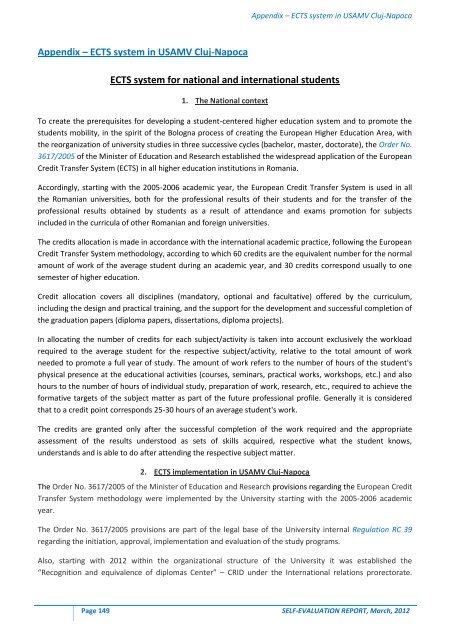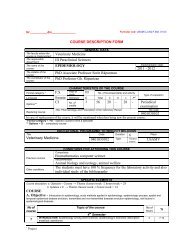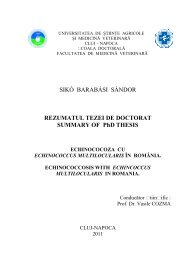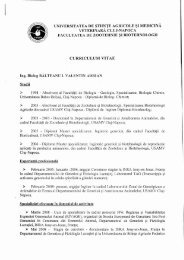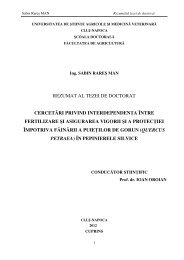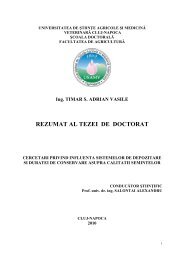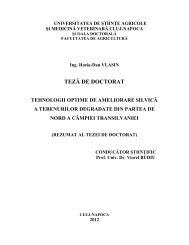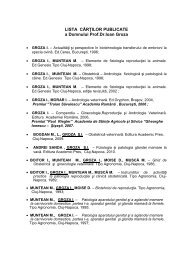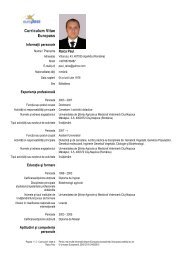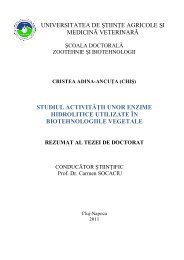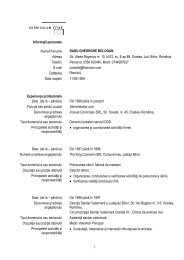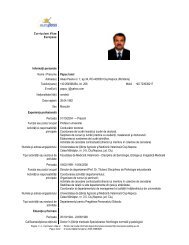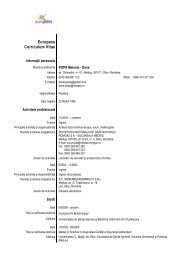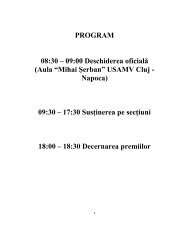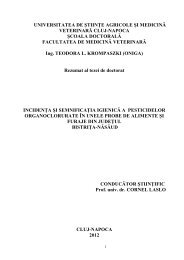self evaluation report - Universitatea de Ştiinţe Agricole şi Medicină ...
self evaluation report - Universitatea de Ştiinţe Agricole şi Medicină ...
self evaluation report - Universitatea de Ştiinţe Agricole şi Medicină ...
Create successful ePaper yourself
Turn your PDF publications into a flip-book with our unique Google optimized e-Paper software.
Appendix – ECTS system in USAMV Cluj-Napoca<br />
Appendix – ECTS system in USAMV Cluj-Napoca<br />
ECTS system for national and international stu<strong>de</strong>nts<br />
1. The National context<br />
To create the prerequisites for <strong>de</strong>veloping a stu<strong>de</strong>nt-centered higher education system and to promote the<br />
stu<strong>de</strong>nts mobility, in the spirit of the Bologna process of creating the European Higher Education Area, with<br />
the reorganization of university studies in three successive cycles (bachelor, master, doctorate), the Or<strong>de</strong>r No.<br />
3617/2005 of the Minister of Education and Research established the wi<strong>de</strong>spread application of the European<br />
Credit Transfer System (ECTS) in all higher education institutions in Romania.<br />
Accordingly, starting with the 2005-2006 aca<strong>de</strong>mic year, the European Credit Transfer System is used in all<br />
the Romanian universities, both for the professional results of their stu<strong>de</strong>nts and for the transfer of the<br />
professional results obtained by stu<strong>de</strong>nts as a result of attendance and exams promotion for subjects<br />
inclu<strong>de</strong>d in the curricula of other Romanian and foreign universities.<br />
The credits allocation is ma<strong>de</strong> in accordance with the international aca<strong>de</strong>mic practice, following the European<br />
Credit Transfer System methodology, according to which 60 credits are the equivalent number for the normal<br />
amount of work of the average stu<strong>de</strong>nt during an aca<strong>de</strong>mic year, and 30 credits correspond usually to one<br />
semester of higher education.<br />
Credit allocation covers all disciplines (mandatory, optional and facultative) offered by the curriculum,<br />
including the <strong>de</strong>sign and practical training, and the support for the <strong>de</strong>velopment and successful completion of<br />
the graduation papers (diploma papers, dissertations, diploma projects).<br />
In allocating the number of credits for each subject/activity is taken into account exclusively the workload<br />
required to the average stu<strong>de</strong>nt for the respective subject/activity, relative to the total amount of work<br />
nee<strong>de</strong>d to promote a full year of study. The amount of work refers to the number of hours of the stu<strong>de</strong>nt's<br />
physical presence at the educational activities (courses, seminars, practical works, workshops, etc.) and also<br />
hours to the number of hours of individual study, preparation of work, research, etc., required to achieve the<br />
formative targets of the subject matter as part of the future professional profile. Generally it is consi<strong>de</strong>red<br />
that to a credit point corresponds 25-30 hours of an average stu<strong>de</strong>nt's work.<br />
The credits are granted only after the successful completion of the work required and the appropriate<br />
assessment of the results un<strong>de</strong>rstood as sets of skills acquired, respective what the stu<strong>de</strong>nt knows,<br />
un<strong>de</strong>rstands and is able to do after attending the respective subject matter.<br />
2. ECTS implementation in USAMV Cluj-Napoca<br />
The Or<strong>de</strong>r No. 3617/2005 of the Minister of Education and Research provisions regarding the European Credit<br />
Transfer System methodology were implemented by the University starting with the 2005-2006 aca<strong>de</strong>mic<br />
year.<br />
The Or<strong>de</strong>r No. 3617/2005 provisions are part of the legal base of the University internal Regulation RC 39<br />
regarding the initiation, approval, implementation and <strong>evaluation</strong> of the study programs.<br />
Also, starting with 2012 within the organizational structure of the University it was established the<br />
“Recognition and equivalence of diplomas Center” – CRID un<strong>de</strong>r the International relations prorectorate.<br />
Page 149 SELF-EVALUATION REPORT, March, 2012


